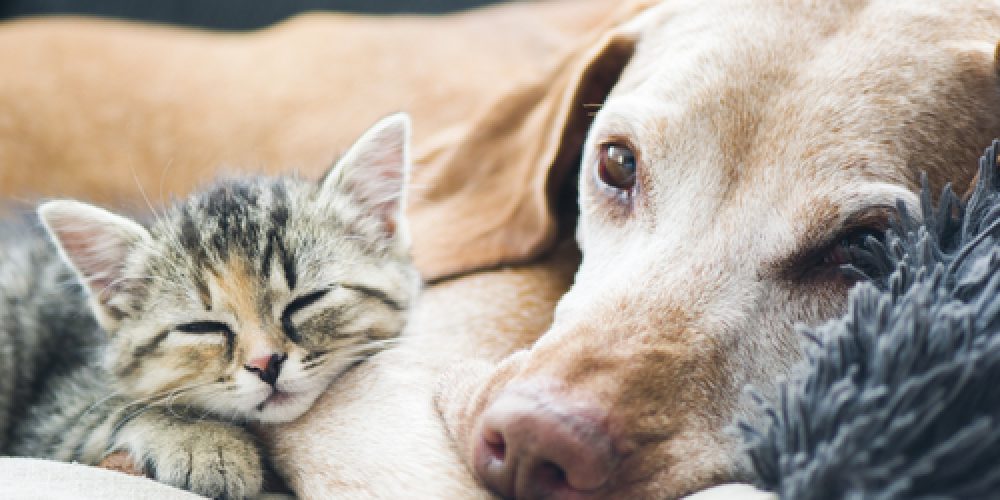Keep your kitten in a separate room at first
Initially, keep your new kitten/cat in a separate room with all the necessary supplies: food, water, a litter box, a comfortable resting area, and a place suitable for hiding.
This allows them to explore and adapt to their new surroundings without the immediate presence of your dog.
When to introduce your new kitten to your dog
Timing is crucial when introducing a new kitten or cat to your dog. It’s best to wait until your cat is comfortable in their new environment and has had time to settle in.
What to look for:
- Exploring: When your cat begins to explore their surroundings in a relaxed way, it indicates a growing comfort level.
- Playfulness: Playful behaviour is a positive sign that your cat is feeling secure and is starting to engage with their environment.
- Purring: Purring is often a sign of contentment in cats. If your cat purrs during interactions, it suggests a sense of comfort and ease.
- Seeking human interaction: If your cat voluntarily approaches and interacts with family members, it demonstrates a willingness to bond and a sense of security.
- Grooming: When your cat engages in self-grooming activities, it signifies a level of comfort and a sense of ownership over their space.
- Sleeping comfortably: Finding your cat comfortably resting and sleeping in various locations around the house is a positive sign of adaptation.
- Use of the litter box: When your cat consistently uses the litter box for elimination, it indicates that they feel at ease in their new home.
It’s important to note that every kitten and cat is unique, and the time it takes to fully settle into a new environment can vary, but it usually takes a week or so.
After they seem settled, you can introduce them to your dog, but before you do, read the next section for some important tips.
Before your kitten and dog first meet
Teach your dog impulse control
Before the initial introduction, work on reinforcing your dog’s impulse control.
Basic obedience commands such as “sit,” “stay,” and “leave it” can be invaluable during the introduction process.
Familiarise your dog and kitten with each other’s scents
Exchange bedding or toys between your kitten and dog to introduce their scents to one another. This helps them become familiar with each other’s presence before they meet face-to-face.
Keep them separate for their first face-to-face meeting
For the first face-to-face meeting, consider using a baby gate or a carrier for the kitten/cat to observe the dog from a safe distance.
This controlled environment ensures the safety of both pets while allowing them to become more used to each other’s presence.
Introduce kitten and dog slowly with supervised visits
Begin the introduction with controlled and supervised visits.
- Keep your dog calm and on a leash.
- Allow your kitten/cat to explore while closely monitoring both of your pet’s behaviours; try to relax too. Remember, pets can sense our anxiety and stress.
- Use positive reinforcement, treats, and praise. These can help associate the presence of the kitten/cat with positive experiences for the dog.
- Always go at your cat’s pace.
Watch your pet’s body language
Monitoring body language is crucial during introductions. Look for signs of stress or aggression:
- If your dog is prey-driven, you’ll need to continue to keep them separate and take things more slowly. Signs of a high prey drive include:
- Focused intense stare
- Chasing behaviour
- Pouncing or lunging
- If your kitten is hissing at your dog, remove the dog and allow them to settle. Wait a few days before trying again.
Consider consulting with a vet or animal behaviourist if the issues persist.
Why is your kitten hissing at your dog?
Hissing is a common feline behaviour when feeling threatened.
It could indicate fear, discomfort or stress.
Understanding and addressing the source of your kitten’s discomfort is essential for a successful introduction.
If this happens, go back to scent swapping and allowing visual access through a stair gate, for example.
Give them more freedom over time
As your cat and dog become more used to each other, gradually increase their interaction time.
Allow them to share spaces and observe their interactions, always prioritising safety and positive experiences.
Don’t make your cat feel cornered, they should have somewhere safe they can escape to hide.
- Providing your cat with high ledges will make them feel more secure.
- Keep any external doors and windows closed but allow your cat to leave the room if they wish to.
- Providing spaces in your home where your cat can find refuge or enjoy some peace and quiet is crucial for their overall wellbeing.
- Ensuring your dog receives attention is vital, be mindful of negative feedback to avoid any association with the new family member.

Introducing a new cat to your resident dog requires patience, preparation, and careful observation.
Familiarise yourself with your pet’s body language and do not rush the process or take any risks.
Remember, each animal is unique, so be flexible in your approach and seek professional advice if needed.
With time and by following these introductions, your new cat and dog can become the best of friends!











